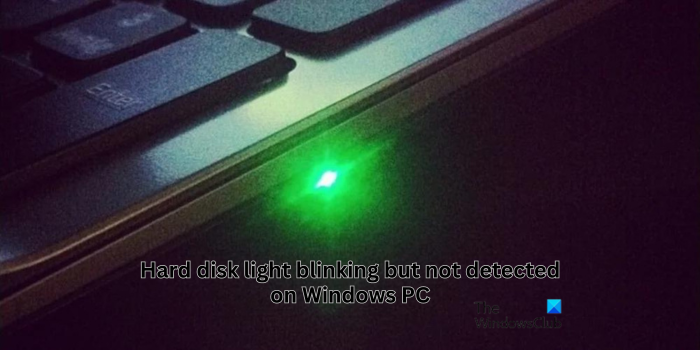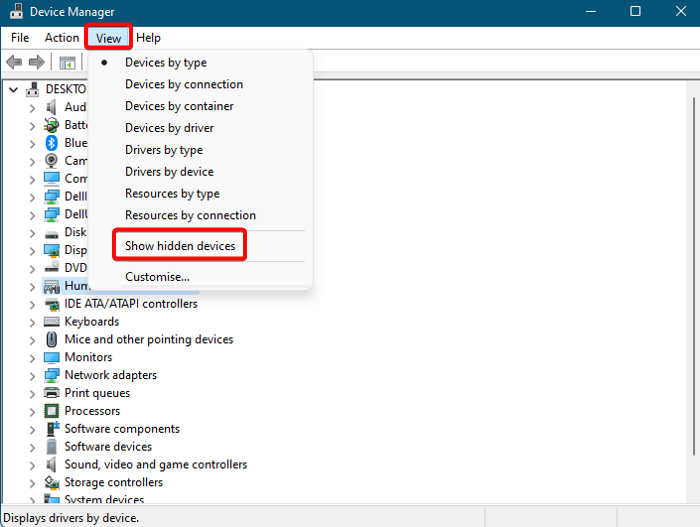If your external hard drive keeps blinking, but Windows doesn’t detect or recognize it, this post will help you.

Why is my disk light flashing on my PC?
Most hard drives have an activity light on them. The light flashes when there is a data transfer going on between your PC and the hard drive. It indicates that your drive is being written to and is being read from. It may be a blinking light, or it may stay for a while on your hard drive, depending upon the manufacturer of the drive. There are some other actions that the blinking light on your hard disk may indicate. These are as follows:
- It might blink when your background services and apps use the hard drive.
- It may indicate the disk check and defragmentation process for HDDs.
- Software updates can be another indication of the blinking light on your external drive.
- It could be a vendor-specific signal. For example, a Red light on a Seagate hard drive shows there is an issue with the drive. If the light is Blue, it indicates the drive is in proper working condition.
- Operating system activities and drive errors (bad sectors, etc.) are other indications of blinking light on your hard drive.
Usually, the blinking light on the hard disk indicates that it is working fine. Now, many users have reported that whenever they connect their hard drive to their PC, the light keeps on blinking, but it is not recognized or detected by Windows. This makes the whole drive inaccessible for the affected users and hampers their work.
The problem may occur due to various factors, including an incorrect USB port, poorly connected USB cables, physical damage, etc. In this post, we bring the working solutions to help you fix this issue.
Hard disk light blinking but not detected on Windows PC
If the activity light on your external hard drive is blinking, but Windows 11/10 is unable to detect it, here are the solutions you can use to fix the issue:
- Some preliminary checks to perform.
- Use a different USB port or cable.
- Change the power management option for the USB Root Hub.
- Show hidden devices.
- Get the help of a professional.
1] Some preliminary checks to perform
First of all, you must check whether the external drive is well connected to your computer. It could be a loose connection causing the issue. So, connect the driver properly and see if the issue is resolved.
There could be some temporary system glitches and bugs triggering the problem. Hence, in that case, restart your computer and then reconnect your hard drive to check if the problem is gone. You must do that before trying anything else as it has proven to be effective for many users.
2] Use a different USB port or cable
The problem might be with the USB port that you have used to plug in your hard drive. So, you can try connecting your drive to a different USB port and see if the problem is fixed.
On the other hand, the USB cable might be damaged or might not be in the correct working condition. So, properly check the cable with which you can connect the hard drive to the PC and see if the problem is fixed.
Read: Hard Drive not showing up on Boot Menu in Windows.
3] Change the power management option for the USB Root Hub

Your power management settings might be causing the issue, especially if the issue occurs after waking your computer from sleep mode. If the scenario is applicable, you can try disabling the USB power-saving option as mentioned below and see if it helps:
- First, open the Run command box using the Win+R hotkey and enter devmgmt.msc in the Open box to quickly launch the Device Manager app.
- In Device Manager, locate the Universal Serial Bus controllers category and expand it.
- Now, right-click on your USB Hub Root and choose the Properties option from the context menu.
- Next, navigate to the Power Management tab and untick the Allow the computer to turn off this device to save power checkbox.
- After that, repeat the above steps for all USB Hub Root devices and then check if the problem is resolved.
Read: USB Mass Storage Device driver not showing or working.
4] Show hidden devices

You can try showing the hidden devices in Device Manager and check if your hard drive is displayed or not. If it is displayed, check if there is an issue with the device
For that, you can follow the below steps:
- First, open the Device Manager app.
- Now, go to the View menu and click on the Show hidden devices option.
- Check if your external drive is listed or not. If yes, see if there is an issue with the drive, like the device is greyed out, a yellow exclamation mark on the device, etc.
- In case the drive is greyed out, right-click on it, select the Uninstall device option, and follow the prompted instructions to uninstall the device.
- Once done, disconnect the drive, restart your PC, and reconnect your hard drive to check if the problem is fixed.
See: Hard drive missing after cloning in Windows.
5] Get the help of a professional
If the above solutions don’t work, the issue is likely at the end of your hardware. The hard drive might be corrupted or physically damaged which is why it keeps blinking but is not detected by Windows. So, you can check your hard drive with a technician and get it repaired or replaced to fix the problem.
See: No boot disk has been detected or the disk has failed.
I hope this helps!
Why is my hard disk detected but not showing in my computer?
If your hard drive is detected but is not opening on your PC, it could be due to bad sectors present on your drive. Apart from that, it could be a virus on your drive causing the problem. A drive letter conflict can be another reason that is not letting you access the hard drive. To fix the issue, get the disk repaired, fix the file system errors, update the hard disk drivers, format the drive, or get it replaced.
Now read: Hard Disk or Partition not detected when installing Windows.
Leave a Reply